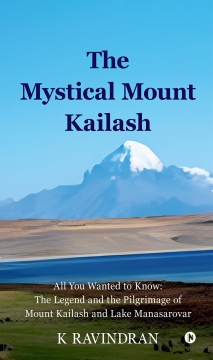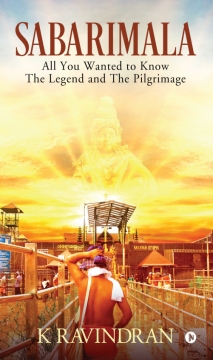
- Discover books
- For Writers
-
For Writers
-
Indie Author Championship
-
Challenges
Writing Contests
- Get Started

"It was a wonderful experience interacting with you and appreciate the way you have planned and executed the whole publication process within the agreed timelines.”
Subrat SaurabhAuthor of Kuch Woh Pal -
-
-
IN
- India
- Singapore
- Malaysia
- 0
K RAVINDRAN
K Ravindran did his schooling in Kerala and Electrical Engineering graduation from Banaras Hindu University, Varanasi. He joined the Indian Air Force in 1963 and worked for over 24 years at various stations all over India in the fields of signals, missiles, radar and communication systems. He took voluntary retirement in the rank of Wing Commander in 1988 and settled down in Vadodara, Gujarat. Thereafter, he pursued his interests in Yoga, spirituality and writing. He has authored four books titled Happy Living (2006), Yoga 360 degrees (2015), Sabarimala (2018) and Twelve World Religions (2022)Read More...
K Ravindran did his schooling in Kerala and Electrical Engineering graduation from Banaras Hindu University, Varanasi. He joined the Indian Air Force in 1963 and worked for over 24 years at various stations all over India in the fields of signals, missiles, radar and communication systems. He took voluntary retirement in the rank of Wing Commander in 1988 and settled down in Vadodara, Gujarat. Thereafter, he pursued his interests in Yoga, spirituality and writing.
He has authored four books titled Happy Living (2006), Yoga 360 degrees (2015), Sabarimala (2018) and Twelve World Religions (2022). He is widely read on varied topics. He has extensively traveled all over the world, including many of the religious pilgrimage centers. He is associated with many social and philanthropic organizations. He is a member of the Retired Officers’ Forum, Vadodara – a senior citizens’ fraternity that promotes social causes and organizes seminars on holistic and healthy living. He is a devotee of the Ramakrishna Mission and is a practitioner of Yoga Asanas and Pranayama for the past three decades. He spends his time reading, writing and a bit of gardening. He has two sons. The present book is his fifth publishing venture.
Read Less...Crop your profile image

The Mystical Mount Kailash
Books by K RAVINDRAN
The majestic and mysterious Mount Kailash, situated in the high-altitude and arduous terrain of the Tibetan plateau, has been attracting pilgrims for centuries. The author has covered the subject in a multi-dimensional manner, exploring geographical, geological, axis mundi, historical, religious, mystical, and mysterious contexts. Various aspects of the circumambulation undertaken by followers of Hindus, Buddhists, Jains, and ancient Bonpos are discussed in de
The majestic and mysterious Mount Kailash, situated in the high-altitude and arduous terrain of the Tibetan plateau, has been attracting pilgrims for centuries. The author has covered the subject in a multi-dimensional manner, exploring geographical, geological, axis mundi, historical, religious, mystical, and mysterious contexts. Various aspects of the circumambulation undertaken by followers of Hindus, Buddhists, Jains, and ancient Bonpos are discussed in detail. These include the outer and inner Parikramas (Koras) of Mount Kailash, the important monasteries, and holy spots on the route, as well as the types of geographical and climatic hazards faced by pilgrims. The nearby holy lake of Manasarovar, invariably visited by pilgrims to Mount Kailash, is also vividly described, including the spiritually refreshing holy dip in its ice-cold water and circumambulation of the lake. Breathtaking color images of the important spots during the approach and circumambulation add to the overall appreciation of the subject.
The multiple routes to Mount Kailash by land and air, through Nepal and Tibet, and the Indian Government-sponsored routes from the west (Pithoragarh district) and east (Sikkim State) have been discussed. Under "Panch Kailashas," the author has briefly described the other sacred mounts, also called Kailash, located in India.
Holy Lands of Abrahamic Religions
Books by K Ravindran
The three Abrahamic religions trace their common patriarch to Abraham, as referred to by Jews and Christians, and Ibrahim as referred to by Muslims. The origin of all three religions was in the West Asian region around Israel/Jerusalem. The West Asian region has been a flash point from prehistoric times and continues to be so even in the present times. The reason for this starts from the Middle Period of 2200 BCE till the 21st century, a span of over 4000 year
The three Abrahamic religions trace their common patriarch to Abraham, as referred to by Jews and Christians, and Ibrahim as referred to by Muslims. The origin of all three religions was in the West Asian region around Israel/Jerusalem. The West Asian region has been a flash point from prehistoric times and continues to be so even in the present times. The reason for this starts from the Middle Period of 2200 BCE till the 21st century, a span of over 4000 years, multiple nations, religions, ethnicities and races had been battling out their differences and viewpoints almost continuously, with few periods of peace and stability in between.
For ease of understanding, the author has divided the book into six parts. The first briefly deals with genesis to modern period, the second with the contradictory claims and counterclaims of the three religions, the third with the holy books and scriptures of Judaism and Christianity, the fourth with the phenomenal survival and growth of modern Israel against heavy odds, the fifth with a historical timeline of Judaism and Israel and the last with an itinerary of a nine-day pilgrimage tour of the holy lands of Jews and Christians.
Twelve World Religions
Books by K. Ravindran
With the proliferating electronic media platforms of social networking sites and the spread of false/doctored news, many lay people get wrong notions on religions/faiths. This leads to religious rivalries, mutual suspicions, hate speeches and increasing religious intolerance, leading to violence taking root in certain areas of the world. It is therefore quite essential for lay people to be familiar with the basic essence and congruence of religions.
Twe
With the proliferating electronic media platforms of social networking sites and the spread of false/doctored news, many lay people get wrong notions on religions/faiths. This leads to religious rivalries, mutual suspicions, hate speeches and increasing religious intolerance, leading to violence taking root in certain areas of the world. It is therefore quite essential for lay people to be familiar with the basic essence and congruence of religions.
Twelve World Religions is an attempt to educate the lay public about this. It gives a kaleidoscopic view of the 12 major religions of the world in a structured, uniform pattern to include the founder of the religion, historical background, concept, beliefs, core teachings, temples/shrines, methods of worship, rituals, societal restrictions, priesthood, proselytization, eschatology, religious texts and scriptures, development of the religion through centuries, interaction/conflict with other religions, the spread of the religion, demographics, diaspora, symbols, etc. The language has been kept simple without any profound philosophy or pedagogy, keeping a lay reader in mind.
India’s ancient Vedas stated that there are many different approaches to God and all are valid. The modern Indian saint Sri Ramakrishna also stated, “As many paths, so many faiths.”
This book is an attempt towards it.
SABARIMALA
Books by K RAVINDRAN
Sabarimala has been lately in the news for recent verdict of Supreme Court allowing entry of women between 10 to 50 year age group to the Ayyappa shrine. The entry of this group was barred due to ancient traditions and customs based on the belief that the idol of Ayyappa, an incarnation of Sastha, is in the form of a perennial celibate. As per popular legends, the 12 year-old Ayyappa, after fulfilling his mission on earth, retreated to the Sabarimala forest, e
Sabarimala has been lately in the news for recent verdict of Supreme Court allowing entry of women between 10 to 50 year age group to the Ayyappa shrine. The entry of this group was barred due to ancient traditions and customs based on the belief that the idol of Ayyappa, an incarnation of Sastha, is in the form of a perennial celibate. As per popular legends, the 12 year-old Ayyappa, after fulfilling his mission on earth, retreated to the Sabarimala forest, entered into eternal meditation and merged with an idol of Sastha, consecrated there earlier. The spontaneous public agitation against the verdict has created a serious law and order problem in the Kerala state, awaiting the review of the verdict, due to filing of many review/writ petitions by various organizations. The pilgrimage by devotees to Sabarimala involves strict observation of penance and abstinence for 41 days before starting the trek. The various legends and stories of Sastha/Ayyappa and the rigorous pilgrimage rituals are not well known to people other than the pilgrims, who are mostly from South Indian states. The book, result of own pilgrimage experience of the author and his painstaking research work, throws considerable light on these aspects.

Are you sure you want to close this?
You might lose all unsaved changes.
Select from one of our global stores to continue
 India
India
 Singapore
Singapore
 Malaysia
Malaysia
Warning Message
The items in your Cart will be deleted, click ok to proceed.














